Pasteurized eggs are so useful to have, especially for homemade cocktails! So many cocktails call for egg whites or whole eggs, and if you're anything like me, you're leery about using raw eggs. Pasteurized eggs are also great to use in frostings, mayonnaise, or any recipe where you just might not cook an egg all the way through. If you're looking for the easiest, most reliable method to pasteurize eggs, sous vide is it!

I first decided to pasteurize my own eggs when I was making a batch of my Homemade Eggnog. A lot of rich and creamy holiday cocktails call for eggs, and I didn't want to have to worry about salmonella. At ALL! Who wants food poisoning during the holidays (or ever??) So I decided to do some research into egg pasteurization.
I've written before about using carton egg whites, which are pre-pasteurized, and how they work well in cocktails (like this Passionfruit Mango Sour) and for making Swiss-method macarons. But, if you need to use pasteurized whole eggs or egg yolks, it's not so common to find in grocery stores.
Luckily, if you have a sous vide machine, it's beyond easy to pasteurize them yourself.
Jump to:
About Sous Vide Cooking
Sous Vide (which means "under a vacuum" in French) is a cooking method in which food is vacuum sealed, submerged in water, and the water is held at a constant temperature for a long time.
This method allows the food to cook through completely without risk of overcooking or burning. Plus, you can plan ahead and leave the food in the water for a couple of extra hours if you need to.
Since we are cooking eggs, we can just skip the vacuum sealing part, since the shell is already a perfect container! In fact, vacuum sealing raw eggs can crack the eggs, so definitely avoid it.
If you don't already have a sous vide machine, I highly recommend the Anova Nano Sous Vide Cooker. I love it because it is super compact, easy to store and works wonderfully. You can also get dedicated tabletop sous vide appliances, which are also great, but large and tend to be more expensive.
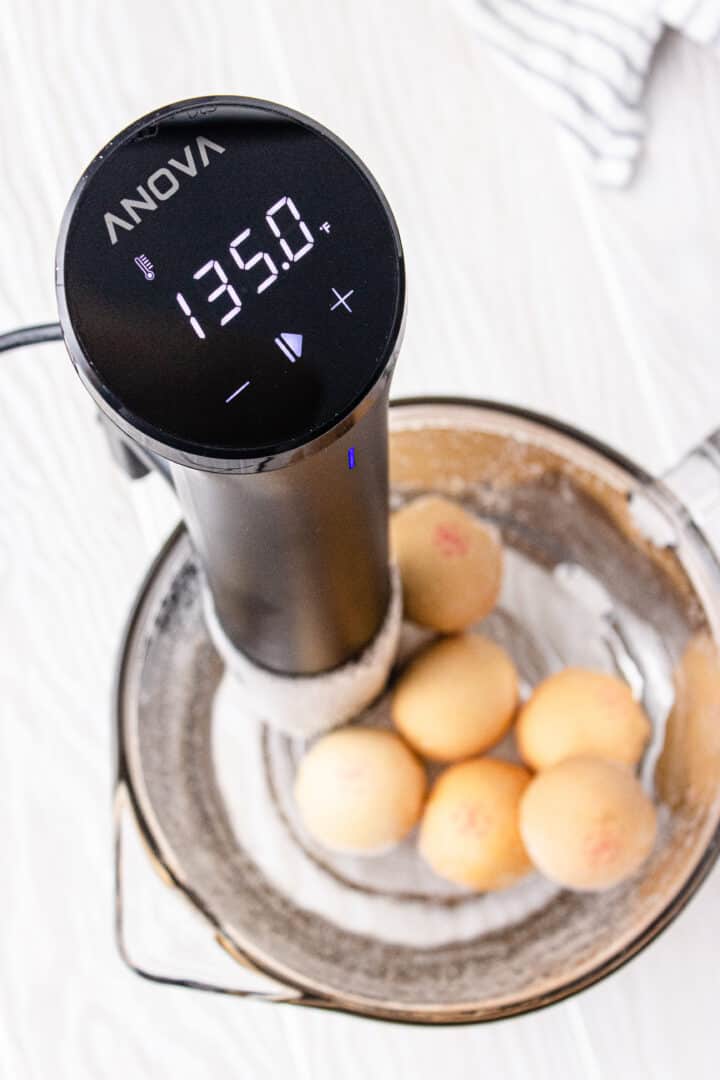
What You'll Need
Here's what you'll need to have on hand to pasteurize your eggs:
- Sous vide machine
- Large bowl or container, at least 8 cups/2 liters in size
- Eggs
- Enough water to cover the eggs and be above the minimum fill line for the Sous Vide machine
- Slotted spoon to take the eggs out of the hot water
- Another large bowl for an ice bath
 Buy Now →
Buy Now →  Buy Now →
Buy Now →  Buy Now →
Buy Now → 
Instructions
To get started, attach your Sous Vide machine to your container. Fill your container with water until it is above the minimum fill line. Leave some space at the top, since the eggs will displace some of the water.
Add your eggs to the water one at a time. This is actually the perfect way to make sure your eggs are fresh. If any of the eggs float, err on the side of caution and discard them. Fresh eggs will always sink.
Set your sous vide machine to cook at 135°F (57°C) for 1 hour and 15 minutes. (Note: this time frame is for United States large eggs, which are around 57 to 60 grams in weight. If you are using larger eggs, you will need to keep them in for longer.)
Then just check on it occasionally to make sure that the eggs are staying under the water, since the current from the machine can cause them to move around.
When it gets close to the end time, prepare an ice bath in your second bowl. Fill it with water and ice cubes, leaving some room at the top so the eggs won't make it overflow.
Once it's finished cooking, use your slotted spoon to remove them from the hot water. Carefully place the eggs into the ice bath and let them chill for 10-15 minutes.
Then, dry them off and use them, or store them in the refrigerator.
Hint: If your eggs are moving around a lot in the sous vide current, you can gently place something on top of them to hold them down in the water, like a small colander.

Storage
After you pasteurize your eggs, you can store them in the refrigerator for up to 30 days from when you purchased them. Once you break the shell, use the egg within 2 days.
For longer storage, there are some ways to freeze eggs. If you separate the egg white from the egg yolk, you can freeze the egg white by itself.
The egg yolk doesn't freeze well on its own, but you can scramble it together with the egg white along with ⅛ teaspoon of salt and/or sugar. That will help it freeze without losing its texture. You can use an ice cube tray or muffin tin to portion out your eggs.
Other Methods of Pasteurization
Although sous vide is a really easy and convenient method, there are other ways to pasteurize eggs at home. The stovetop method is the quickest way to do it, but it comes with some drawbacks.
Stovetop
As long as you are able to keep the temperature of the water consistent, you can heat the eggs submerged in water on your stovetop. For this reason, I do NOT recommend trying this on an induction burner. The heat cycles when using induction, going higher and lower than the power you set it to. If the water goes above 142°F (61°C), the eggs will begin to turn solid inside.
If you are using a gas stovetop or an electric stovetop with reliably steady heat, just keep the temperature of the water at 140°F (60°C). Heat the eggs in this temperature water for 3½ minutes. Since it is a higher temperature, the bacteria will die in less time, but with the high temperature comes a greater risk of changing the egg's texture and damaging the foaming ability of the egg whites.
You can also do the lower temperature method on the stovetop (135°F (57°C) for 1 hour and 15 minutes).
Slow Cooker
You can also use a slow cooker. This is kind of the same method as sous vide, but you have less control over the temperature. If your slow cooker has a low or precise temperature setting, test it out by filling it with water.
After about an hour, use a probe thermometer to check not only the temperature of the water, but also the temperature of the bottom of the slow cooker. Again, the eggs will start to get solid when exposed to a temperature above 142°F (61°C). You want to be able to keep it at 135°F (57°C) for 1 hour and 15 minutes, or a higher temperature for a shorter time.
The reason that sous vide is more reliable than the slow cooker is the water circulation. The machine keeps the water moving, so it stays at a consistent temperature without hot spots.
Other Methods
There are actually many other methods of egg pasteurization. If you want to really do a deep dive into this topic, I definitely recommend starting with this PDF: International Egg Pasteurization Manual from the American Egg Board, or their own stovetop pasteurization instructions. It's a very thorough resource!
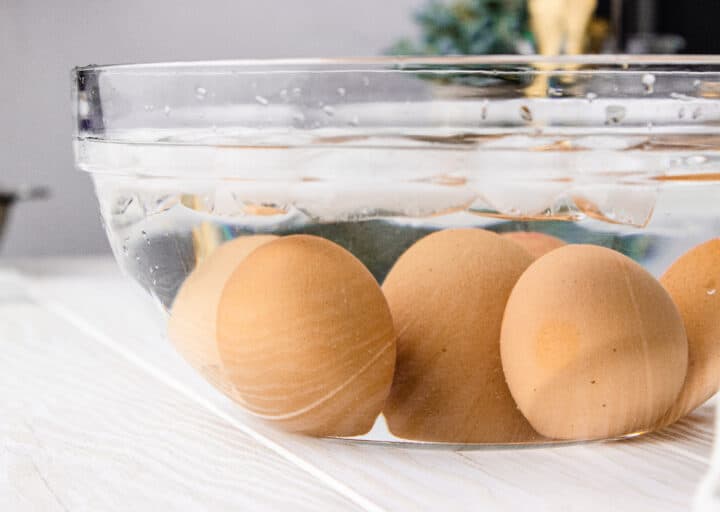
Frequently Asked Questions
Well... technically, they are no longer raw! Even though they're liquidy, they have been cooked at a high enough temperature for long enough to kill any bacteria present. You can consume them in the liquid form after pasteurization.
Absolutely, as long as you are able to control the temperature precisely. With the stovetop method, you will need an accurate food thermometer and a reliable burner. With the sous vide method, the machine takes care of the temperature itself.
According to the U.S. Department of Agriculture's website: "No one should eat foods containing raw eggs.... However, in-shell pasteurized eggs may be used safely without cooking." [source website]
Top tip
If you know you are going to use only the egg whites or the egg yolks in a recipe, you might want to consider separating them before pasteurizing. To pasteurize, then, you would need to add the liquid whites or yolks to a vacuum-sealed bag. You can certainly separate them after, but the yolks are a little more delicate and easier to break afterwards, which makes them harder to separate. (But it's doable if you have a lot of egg separating experience!)
📖 Recipe
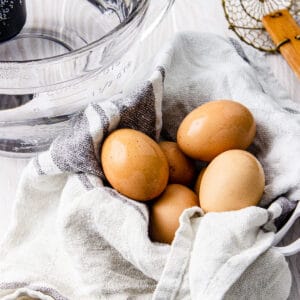
How to Pasteurize Eggs Sous Vide
Equipment
- Large pot or other large container, at least 2 quarts/2 liters in volume
- Slotted spoon
- Large bowl for ice bath
Ingredients
- water
- 6 eggs You can use any amount of eggs that fit into your sous vide container.
Instructions
- Attach your sous vide machine to the side of your bowl.
- Fill the bowl with water until it reaches the minimum fill line.water
- Add the eggs one by one, testing each egg to make sure they sink instead of float. Discard any eggs that float.6 eggs
- Check to make sure the water is not overflowing the bowl or going over the maximum fill line of your sous vide machine. If it is, empty some water out, making sure to keep the eggs fully covered and the water above the minimum fill line.
- Set the sous vide machine to cook at 135°F (57°C) for 1 hour and 15 minutes and start the cooking cycle. (Note: this time and temperature combination is for United States large eggs, which are around 57 to 60 grams in weight. If you are using larger eggs, you will need to keep them in for longer.)
- When the machine is close to being done, set up an ice bath for the eggs in a separate bowl by filling it with cold water and adding some ice. Make sure not to fill too much so you don't overflow it when adding the eggs.
- When the machine is done, use a slotted spoon to remove the eggs from the hot water and place them in the ice bath.
- Let the eggs chill in the ice bath for 10-15 minutes.
- Carefully dry off the eggs, and optionally mark them with a permanent marker. Store the pasteurized eggs in the refrigerator for up to 30 days from when you originally purchased them.

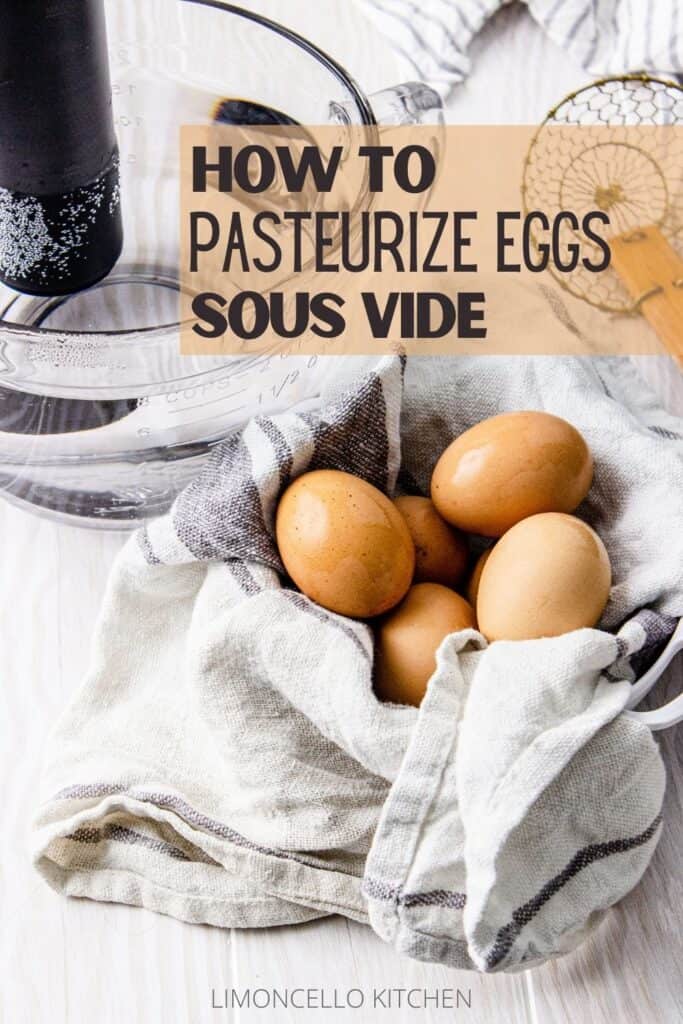

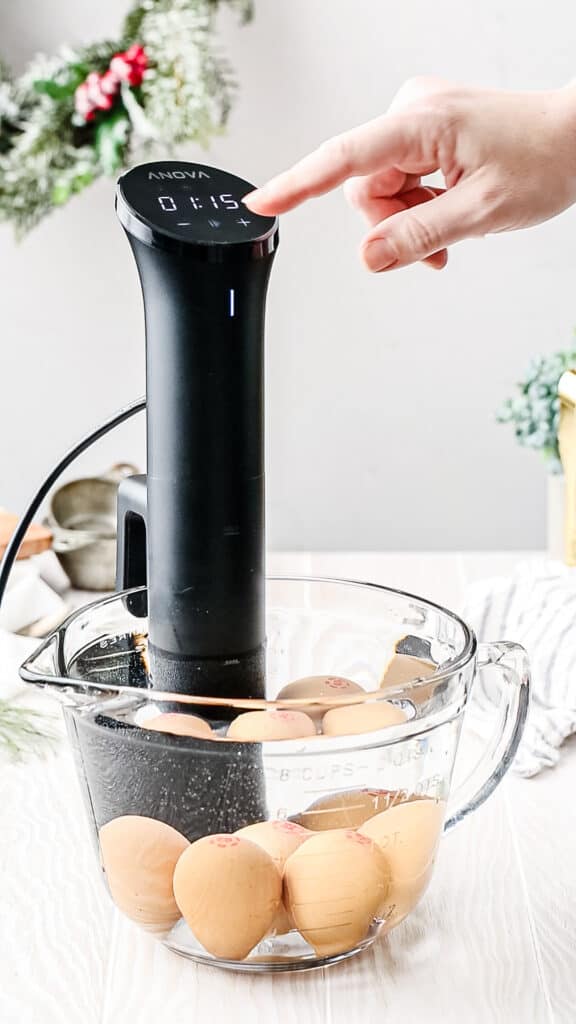

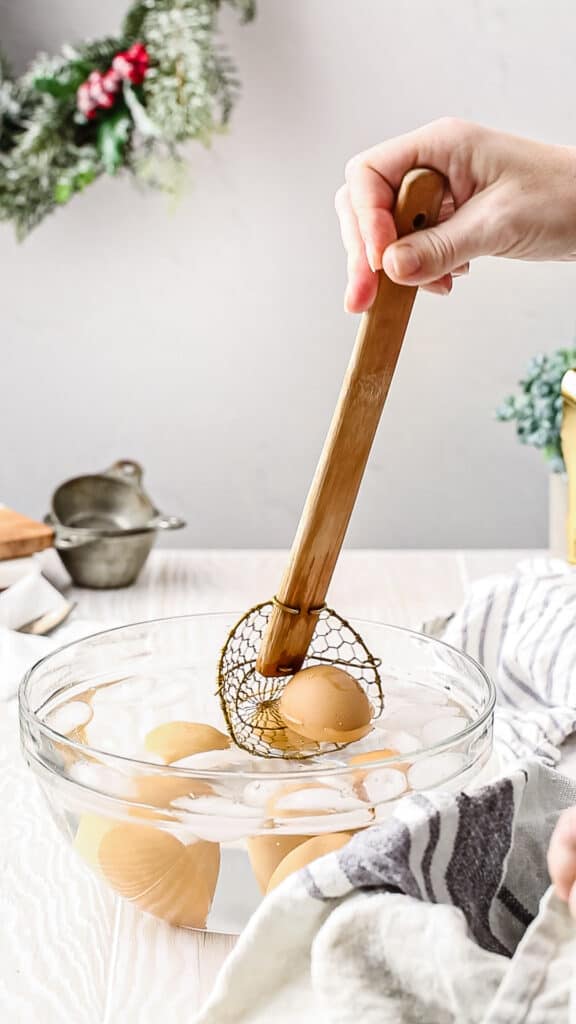
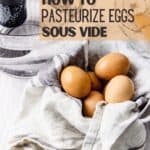
Arie says
I pasteurized at 57 deg. C, according to your recipe, but the process spoiled the egg whites: they became unwhippable in mixer. Then I tried at 55 C, and it was OK with the whites, but I am not sure they where fully pasteurized during 1 hour and 15 minutes. I guess I have to increase the time accordingly, but I don't now by how much. Can you give a good time estimate for 55 deg. C?
Kimberly says
Hi Arie! Thanks for your question. At 57°C (~135°F) the whites will work for cocktails, but for meringues it is a little more tricky. You will need to add some acid, like cream of tartar, and more than you would use for non-pasteurized whites (¼ teaspoon per egg white). For pasteurizing at 55°C (131°F), you are right, it does take longer. You will need to hold it at that temperature for about 3 hours, but it does help to keep the egg white more whippable. (Source article: Pasteurization of eggs in the shell)
Arie says
Hi Kimberly! Thanks for your reply. What do you think of the following idea: separate the yolks and the whites into two ziploc bags and keep them in sous-vide at 55°C. Shouldn't it shorten the times of keeping them in sous-vide?
Kimberly says
Hi Arie! You can absolutely do it that way. You could vacuum seal the bags, but if you are using ziploc, you can use the water seal method to get all the air out. (More info on that here: https://anovaculinary.com/ja/sous-vide-water-displacement-method/) This will be much quicker, about 30 minutes, but you will want to take the bag out every 10 minutes and swish the egg liquid around inside the bag so it is heating evenly (wearing oven mitts of course!) If it's vacuum sealed you can store the bag in the fridge for about 7 days, or 2 if you open up the bag.